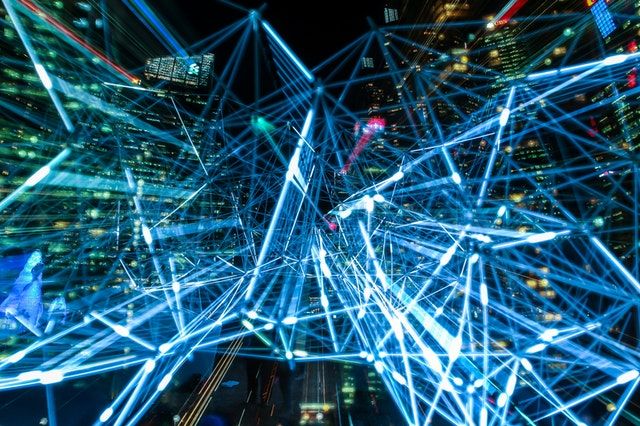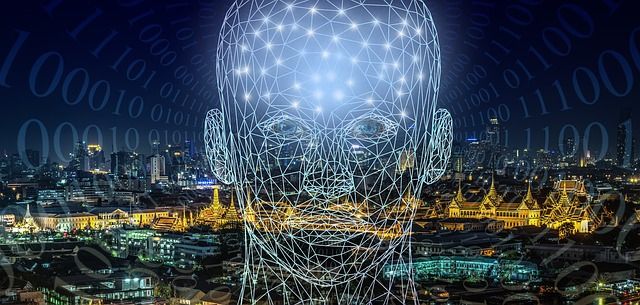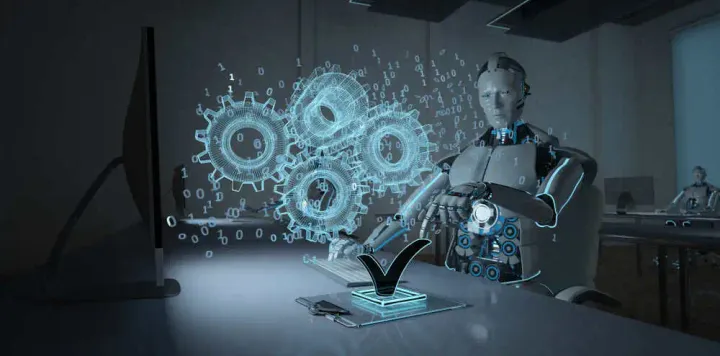Is AI eco-friendly?
Artificial Intelligence (AI) systems can be used to reduce carbon emissions and eventually environmental degradation. It has the potential to understand the surroundings autonomously, learn from experience, make and implement decisions, and communicate with the surroundings.

Over the last few years, human activities have greatly contributed to climate change elevating the global temperature to its peak. To envisage the terrestrial changes, the GRACE satellite was installed in 2002. This satellite revealed alarming data of good 15 years (from 2002-2017) for our planet Earth. This data revealed horrible facts including groundwater and ice depletion with 140 billion tons ice loss in Antarctica and 260 billion tons ice loss in Greenland on annual basis as a result of increased global temperature.
As humans, we are responsible to protect our planet by using more eco-friendly technologies. Advanced technologies used to slow down the climate change crisis are the solution to this problem. In this context, we need to think about how to get benefits from the technological innovations to endorse environmental sustainability and establish a worth living world. This is the point where AI raises its hand. AI is believed to be a technology that is providing eco-friendly solutions to tackle the problems faced by our planet.
AI that refers to the advanced machine's intelligence has the potential to understand the surroundings autonomously, learn from experience, make and implement the decisions, and communicate with surroundings whether there are humans or other machines.

What makes AI eco-friendly?
AI systems can be used to reduce carbon emissions and eventually environmental degradation. It can reduce carbon output in the following ways:
- Resource decoupling –that is cutting short the resources such as by prospecting crop yields or monitoring cooling and heating of the environment.
- Impact Decoupling – it means reducing the environmental harm by deploying smarter planning systems. E.g., by projecting energy consumption thus enhancing the planning of renewable energy sources.
Moreover, the following three benefits of AI for any industry make it eco-friendly:
Error Reduction – Humans making mistakes is a natural phenomenon. While performing manual tasks, human beings commit errors that have to be redone. While addressing these avoidable problems more energy is consumed because of doing a task again and again for corrections. By using AI, this human error can be reduced to a great extent that will ultimately reduce energy use. Less energy consumption in any industry always results in a clean environment on account of less emission of gases or pollution.
Greater Efficiency – Several types of AI like ML, DL, and NLP can be combined to improve the efficiency of a process while reducing energy use. AI can also eradicate superfluous steps from an existing process hence reducing the energy consumption at multiple steps.
Reduced use of Raw Materials – AI has the potential to cut short the use of raw materials and can be employed to determine the low-carbon materials for a product. Besides reducing the use of raw materials, researchers are unleashing the prospective of new eco-friendly materials by using databases and AI. This is getting helpful to restrict dependencies on raw materials that are not environmentally friendly such as plastic. Researchers have discovered a lot of materials such as metal oxides. These metal oxides by capturing sunlight and changing it into energy can increase solar cell efficiency.
Furthermore, many AI projects are eco-friendly. For instance:
Green Horizon project – The Green Horizon project of IBM in China, is employing Artificial Intelligence to project air pollution. It also helps in tracking the sources of pollution and then developing strategies to tackle this pollution. It also helps in determining if it is a prerequisite to reduce the number of drivers or shut down some power plants to reduce air pollution. Moreover, IBM is also deploying AI for having a better forecast of the weather and is succeeded in making 30% more accurate predictions. IBM with its AI model is helping renewable energy companies to capitalize on the production of renewable energy and decrease carbon emission.
AI for Earth – Microsoft believes that AI is a game-changer for environmental problems and climate change. Its AI for Earth program launched in 2017 has invested $50 million for the past five years to develop and test new AI applications that are eco-friendly.
Microsoft Azure – Microsoft runs cloud offerings that are huge public data centers with the name “Microsoft Azure”. With such efforts, Microsoft claims that by 2030, it would become carbon negative.
Google Cloud Platform – Google has developed an AI training model itself to cut short the energy use so that its data centers remain cool down. AI model is used to lessen the energy burden of Google’s data centers. As per a report in 2016, Google, using the AI model, succeeded in achieving a 40% energy reduction in cooling. Google offers these eco-friendly AI-based services to other companies with the name of “Google Cloud Platform”. Companies must take advantage of this platform to ensure a sustainable environment.

AI helping Thermal Power plants in reducing Cost and Pollution
Coal-fired thermal power plants cause severe pollution leading to global warming, acid rain, and other environmental issues. In the US, coal plants are reported to emit 42% of mercury in the environment making it highly toxic to live in. In addition to mercury, coal plants emit nitrogen oxides, sulfur dioxide, and carbon dioxide, etc., in the surroundings. Carbon dioxide is the main byproduct of coal combustion that results in global warming. Coal comprises 60-80% carbon and with the burning of 1 mole (12g) of carbon, almost 44g of CO2 is emitted.
In India, thermal power plants are mostly running on coal, as it has always been the cheapest fuel source for a developing country. The burning of coal accounts for more than 70% of the total electricity of India. This huge coal burning is overriding apprehensions over climate change, along with pollution and carbon emissions. To mitigate this environmental damage by thermal plants, there is a need to reduce the amount of coal consumption by improving efficiency through the use of new technologies such as AI. Keeping this in view, Rahul Raghunathan, cofounder of a Bengaluru-based startup named "ExactSpace", has the ambition to use AI in thermal power plants to improve operational efficiency and predictive maintenance. In a thermal power plant, AI helps in decreasing fuel inputs that eventually result in creating a more pleasant environment on account of reduced carbon emission.
China has always been relying on fossil fuels to run its thermal power plants and is contributing 30% of greenhouse gas emissions worldwide. AI systems are recently being introduced in the thermal power plants of China. The AI systems used in power plants of one of China's cities, Langfang, are now automatically adjusting variables for thermal boilers. JD Digits has launched an AI-powered system to improve efficiency and reduce greenhouse gas emissions from their thermal plants. With the advanced AI-powered system, the boilers' combustion efficiency has increased to 93.9%. More the combustion efficiency less will be the emission of gasses and the more sustainable environment we will have as a result of AI.

Climate Crisis and Eco-friendly Applications/Solutions of AI
COVID-19 pandemic shocked the entire world resulting in a large number of deaths, economic instability, and social disruption. In this pandemic, while worrying to fulfill our basic needs, we must not forget that another catastrophe is forthcoming: Climate Change.
We must use technology that is eco-friendly to survive this climate crisis. One thing that we have learned from lockdown is that staying at home and down-turning the economy is not sufficient to tackle the climate crisis. CO2emission is still more than 80%, though it is 17% less than that of 2019. We need to act decisively; otherwise, climate change will result in an economic crisis in the next 20 years. And this economic and climate crisis is believed to be as horrible as the COVID-19 pandemic in ten years.
The climate crisis is worsening as our planet is getting warmed over time. When the forests are damaged, surplus CO2 is emitted into the atmosphere as a result of vegetation decomposition, making the environment unfriendly for living. When the trees grow back, they store less amount of carbon for being smaller. If we face extreme hurricanes and storms as a result of climate change, some forests will be completely damaged and will not recover. Consequently, we will have surplus carbon in our atmosphere, accelerating global warming. There were 772 disaster and weather events in 2016 that were three times more than those that occurred in 1980. Most species are getting extinct from the planet and by the 21st century, this percentage is expected to rise to 50% with a rise of 30C in global temperature.
Thanks to AI, its eco-friendly applications and solutions help us manage climate change and protect the environment in the best possible way.
AI is believed to be very useful to save the environment from the adverse effects of climate change. AI-enabled autonomous systems are being proved very helpful in fighting against climate change. An Intel study revealed that 74% of respondents believed that AI will be very helpful in solving long-term challenges to the environment. In recent years, remarkable AI applications and solutions are being developed to monitor Earth's resources in a better way. Let's have a look at a few of the eco-friendly applications/solutions of AI:
Autonomous Vehicles
Regular urban transport has substantial emissions of greenhouse gases. This emission can be reduced by optimizing route and traffic through AI, eco-driving algorithms, and autonomous services of ride-sharing.
Smart Agriculture
AI-enhanced agriculture comprises automated data collection, along with corrective actions and decision making. In the field, AI-based sensors are used to determine soil composition and monitor the moisture of crops. Incorporating the information received from the sensors with that of drones helps the autonomous AI system to determine the best planting, spraying, and harvesting time along with fertilizer needs. It also determines the best time for pesticide spray to prevent crops from diseases. Hence AI helps in improving crop production and decreasing pesticide use. AI also helps in detecting crop diseases and optimizing agricultural inputs, hence ensuring boosted agricultural resource efficiency, cutting down the use of fertilizers, water, and pesticides. The surplus use of these resources could damage the significant ecosystems while increasing the flexibility to climate extremes. Similarly, an AI-based irrigation system can save nearly 8,800 water gallons annually for each home, which helps conserve resources.
In India, 30% per hectare increased yields of groundnut was reported with the use of AI that helped the farmers in land preparation and provided the best amount and time for fertilizer, water, and pesticides applications.
Smart and Real-time Disaster Response
When it comes to protecting lives and the environment, prediction and preparation for disasters are the key points. AI helps in analyzing simulations and provides real-time data on disasters. This helps to get prepared before time and provide alerts with emergency services to save human lives and the environment in the best possible way.
Eco-friendly AI-powered products
The innovations in AI and ML are very useful in developing environmentally friendly products and services. AI can enable a product to confront environmental problems based on autonomous actions. At present, we have numerous devices like a Nest Smart Thermostat that has the potential to save 15% on cooling and 10-12% on heating bills on the average, for each household.
Most importantly, businesses are creating AI-powered products like Robots. These robots, on account of their autonomous interactions with surroundings, can perform eco-friendly tasks with great efficiency and handle environmental issues like removing pollutants or waste. Let’s discuss how AI is proving to be eco-friendly in the form of AI-powered robots:
Fighting wildfires
Wildfires are becoming very common worldwide in recent years. The US alone faces around 70,000 wildfires on annual basis. This wildfire is polluting our environment causing great damage to plants and animal species. AI-enabled robots can help in controlling wildfires and protecting the lives of firefighters as well. AI-powered robots have GPS, heat sensors, and computer vision and are equipped with water propelling agents and fire extinguishers. These robots can control fire with more ease and less time as compared to humans hence ensuring a more sustainable environment.
Waste management
AI-enabled robots are used for household garbage collection. AI algorithms used in these robots figure out the optimal route and process for waste collection. Thus, the waste collection procedure is streamlined resulting in environmental protection. Robots help in quicker and more efficient sorting of waste material as compared to humans. This decreases the cost and input power as well resulting in a more sustainable environment.
Reducing Water Pollution
Human activities involving oil and gas are increasing water pollution. AI-enabled robots can help in reducing this pollution caused by the leakage of oil, gas, and chemicals from factories. A robot named "Row-Bot" walks on water, eating and digesting the water microbes and turning them into energy. This robot can function for several consecutive months and produce more energy than consumed. AI-powered robots, besides helping in reducing the oil and gas leakage impact, can also take out chemicals from oceans.
Moreover, many tasks that humans find difficult to perform and are hazardous and time-consuming for humans, can be performed with the help of AI-enabled robots. If humans do these tasks, there are more chances of error. This will result in more energy consumption and pollution as a result of reworking to correct the errors. An AI-enabled robot is not prone to mistakes. If a robot is used to perform such difficult tasks, the chances of error are reduced. Hence there will be no reworking, and consequently less energy consumption and pollution. Thus AI is believed to be ecofriendly as its applications like robots help in reducing energy consumption and eventually the pollution.

AI – a mixed blessing
AI has a dual role. It is believed to have the potential of both generating carbon emissions and reducing those emissions at the same time. The tech experts are raising concerns that while AI is leading us to a smart future; it could harm our environment as well. Besides assisting conservationists and researchers in dealing with the impacts of climate change, AI itself is a contributor to carbon emissions.
Carbon Footprint of AI itself
AI is evolving exponentially. Today, we just have to pull out our mobiles and use multiple apps to improve our daily activities and quality of life. These technologies, powered by complicated algorithms and coding are affecting a great deal on how we interact with our surroundings. However, AI has some downside impacts on the environment as well. According to the world economic forum, AI can speed up the process of environmental degradation. Energy-intensive GPUs that are used for ML training algorithms contribute to increased emissions of carbon dioxide.
The processors being used to develop AI algorithms consume enormous electricity. Hence, with the more and more use of AI, its energy consumption is increasing along with carbon emissions. And both of these factors are elevating environmental concerns.
What is the reason behind enormous energy consumption by AI?
The most significant factor behind enormous energy consumption by AI is the use of Deep learning that is an AI algorithms branch dealing with extensive data. An associate professor at Boston University states that the Deep Neural Networks used in advanced ML algorithms are gigantic mathematical models with billions of parameters that assist neural networks to figure out the solution of complex problems such as face and voice recognition, coherent text generation, and image classification, etc. The neural networks need to be trained to perform these complicated tasks and the training involves tuning the billions of parameters by doing complex calculations on plenty of examples. According to Saenko, the worst thing impacting the environment is that the neural networks don't learn anything promptly just after having a look at the training examples; it demands examples to be shown numerous times to enable its parameters to get optimal accuracy. Moreover, these systems have to process huge data, demanding extensive servers and energy to avoid data centers from heating up. The whole of this process consumes extensive electricity. In the US, 2% of the total electricity is used by data centers. A study by researchers conducted at Massachusetts University, Amherst, revealed that over 626,000 pounds of CO2 can be emitted as a result of enormous energy consumption while training a deep learning algorithm called a "transformer". This emission is five times more surplus than that of American cars. Another study revealed the emission of 192,000 pounds of carbon dioxide while training different AI algorithms including Chess-playing, and Google's Go.
Fortunately, all AI systems are not that costly and dangerous for the environment in terms of carbon emissions. The use of transformers is in fractions of DL models. These are most of the times used in advanced NLP systems like BERT and OpenAI's GPT-2 that are recently introduced. Further, once the training of a DL model is done, it demands a little bit of power. A trained network just needs to have a glance at input data to present output. Hence, the inference is quite less expensive to do computationally.

Conclusion
AI is among the biggest buzzwords in this digital era. Many experts believe that AI has huge potential to confront climate change and protect the environment. AI helps to reduce the climate crisis in several ways. It helps to monitor CO2 levels in the atmosphere and also provides certain solutions to reduce these carbon and other harmful gases emissions making the environment more pleasant for living beings by reducing pollution. AI is also used to optimize energy usage and its distribution. AI can reinforce the predictions about climate and is very helpful in making smarter decisions for decarbonizing industries. AI helps industries in designing low emission infrastructure. Further, many eco-friendly AI applications are being used in industries to reduce their carbon footprints. AI-powered robots can manage household waste and water pollutants autonomously. All of these AI applications and products are posing a positive impact on the environment.
Despite all its benefits in reducing environmental degradation, AI itself has some carbon footprints on account of enormous energy used to cool down its gigantic data centers. However, AI models producing huge volumes of CO2 are not commonly used at present. The AI training algorithms mostly used today generate comparatively minor amounts of CO2. Hence, this negative impact of AI on the environment is in the fractions when compared to its contributions towards making the environment sustainable.
Finally, it may be concluded that AI proves itself to be eco-friendly by making us smarter and faster enough to reduce the environmental degradation caused by pollutants and climate change.



